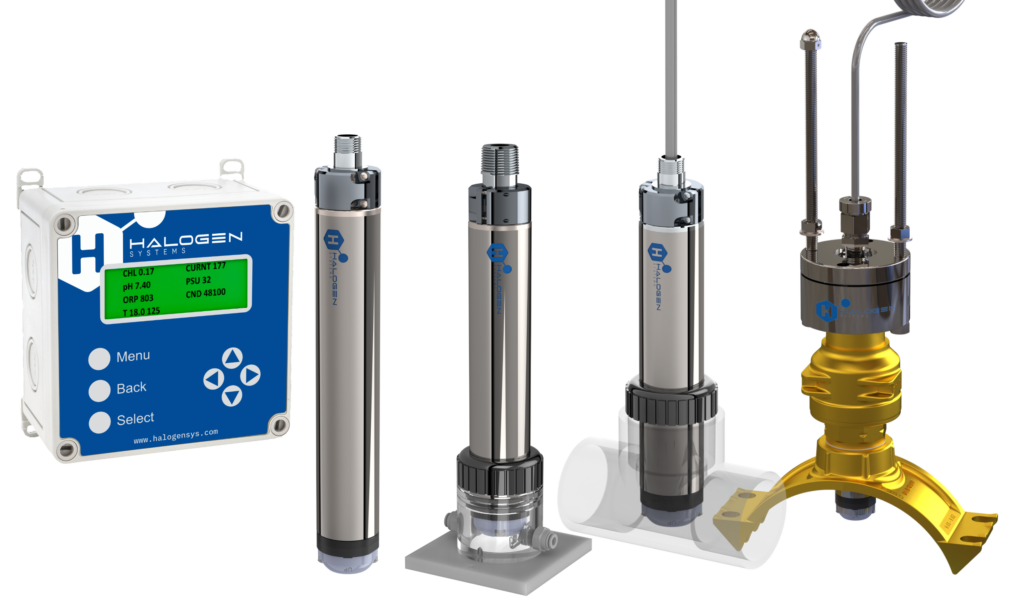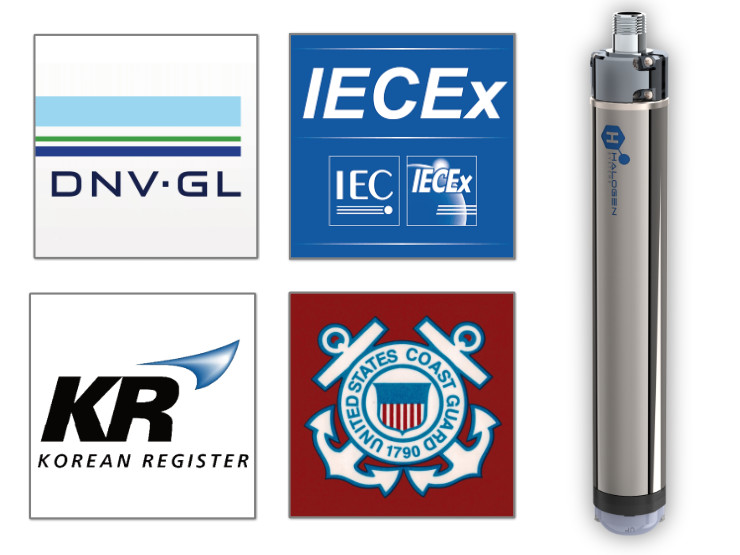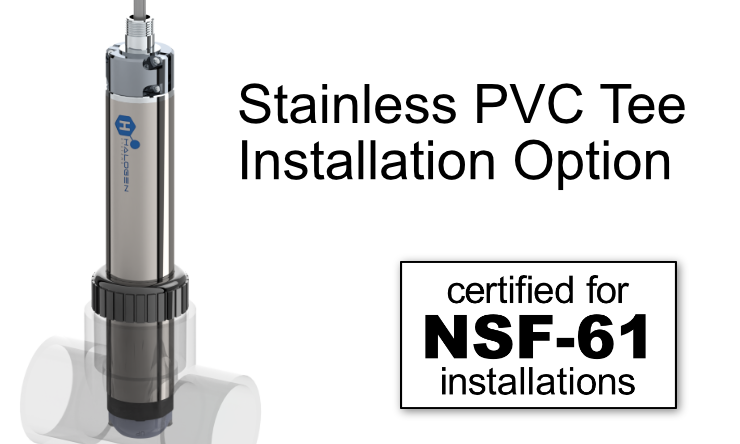- Info CenterHalogen SensiCLĒNE™ The MP5™ was created with stable calibrations and low maintenance as priority requirements. To that end,...Real Talk about "Continuous Monitoring" Chlorine Analyzer claims Some manufacturers of online chlorine analyzers are making bold claims...
- Industries & ApplicationsMaritime & Aviation
Potable Water
Airport & AirPLane Monitoring
Inflow Source Monitoring
Tanker Monitoring
INDUSTRIALCommercial Buildings
Industrial Processing
Applications - ProductsHalogen SensiCLĒNE™ The MP5™ was created with stable calibrations and...Real Talk about "Continuous Monitoring" Chlorine Analyzer claims Some manufacturers...
- Contact
Halogen Systems Inc Technologies & Benefits
HSI’s amperometric analyzers have several unique advantages whether deployed in seawater as a TRO sensor, municipal drinking water chlorine analyzer, or wastewater chlorine sensor. The benefits of the Halogen Systems technology overcome many of the drawbacks of existing membrane amperometric and reagent feed systems commonly used.
High on the list of benefits are flow independence, self-cleaning electrodes, and lengthy calibration retention. These benefits are common to both the seawater-specific TRO series and the MP5 family. Both employ three-electrode amperometry using bare electrodes, an integrated cleaning system, and a built-in pH sensor. The integrated sensor package creates a durable, reliable, and cost-effective analyzer unlike anything else. See the list below, and click on the headers for additional information.
The amperometric sensor can also measure total residual chlorine levels up to 20 ppm. A magnetically coupled pump in the sensor tip provides a fixed constant flow across the electrodes. All amperometric sensors are flow sensitive. Generating consistent velocity, sensitivity, and signal-to-noise ratio is better for lower TRO detection levels. The integrated pump uses a Brushless DC motor. The impeller is made from an engineered polymer formulation, creating low friction and long life.
Halogen uses a bare 3 electrode sensor, eliminating the need to replace clogged membranes or replenish electrolyte required by conventional amperometric sensors. This results in much lower maintenance requirements. In competing amperometric sensors, diluted electrolyte requires periodic sensor recalibration. Halogen’s technology needs no electrolyte and this allows their analyzers to hold calibrations much longer. For more information, see the Amperometric Technology page.
The Halogen chlorine sensors have a patented cleaning feature called SensiCLĒNE™. Polymeric beads held within the sensor cap abrade the electrodes to minimize biofouling and remove calcium carbonate that typically deposits on the electrodes during operation in seawater. The polymeric beads are motivated by the flow from the internal pump. For more information, see the SensiCLĒNE™ page.
HSI’s chlorine sensor does not require reagents or a waste stream, lowering maintenance and installation costs. Colorimetric systems, such as the Hach CL-17 require reagent replenishment every month and periodic replacement of pump and optical components. These can be difficult to troubleshoot, and the tubing is subject to biofouling requiring replacement. Reagents and parts can exceed $600 per year plus labor.
Most competitor amperometric sensors often still require membranes and electrolyte and so do not reduce maintenance or water waste. Unlike the MP5™, at time of writing no other amperometric chlorine sensor is approved for NSF-61 usage in drinking water without a required waste stream.
Halogen’s MP5™ is the only amperometric chlorine sensor approved for NSF-61 usage. it can be installed as a side-stream unit, directly in a pipe, or submerged in a tank with no required waste stream. This makes the MP5™ a good foundational component for drinking water applications such as remote reservoir monitoring, or dead-end water aging analytics.
HSI’s sensor measures five different parameters every minute: TRO, Oxidation Reduction Potential-ORP, pH, Salinity, and Temperature. The sensor uses these measurements to compensate for changes detected in the water source. While the pH of seawater does not change much, in brackish or freshwater, the pH can change drastically. Even when used in freshwater, the sensor can use conductivity measurement to compensate for signal changes. In addition, the temperature sensor allows the sensor to make compensation for all the parameters over -2 ° to 35 °C. These readings enable the sensor to operate and deliver accurate readings in virtually any water condition that a ship may encounter.
Our sensor’s electrochemical stabilization technique is unique. We use this technique to prevent the passivation of the electrodes. Passivation due to organic poisoning is a frequent problem with bare electrode amperometric sensors. This approach enables our chlorine sensor to stabilize and provide accurate readings, usually within one to two minutes. In contrast, our competitor’s bare electrode sensors require up to 24 hours after starting up for reliable readings.
Our sensor measures water at velocities from zero to 4.5 meters per second with less than a 5% change in signal. It can accomddddplish this thanks to its integrated pump. HSI has the only total residual chlorine sensor capable of direct insertion into a pipe.
Eliminating the need for a waste stream simplifies the installation and maintenance. The Hot Tap version, shown in Figure 2, enables us to remove the sensor from the plumbing without the need to drain the plumbing. The Hot Tap installation method rids the use of a sampling pump, switching valves, sampling lines, and sample filtration. This method significantly lowers installation costs.
Halogen uses a unique pH cartridge in its chlorine sensor system. The pH cartridge can withstand 10 bar to -0.7 bar pressures and rapidly wets if allowed to dry out, with its accuracy restored within 3 minutes. HSI is the only company with this type of pH electrode designed with these specifications in an amperometric chlorine analyzer. It does not require calibration for a year or affmore, and the cartridges last two years.
Halogen Systems Inc.’s research and development of this novel technology have resulted in being granted five US Patents, two Korean Patents, one Chinese patent, and others pending. Our chlorine sensor has overcome many limitations in the existing technologies for measuring total residual oxidant (TRO) found in virtually all types of water.

Have Questions? Get Answers.
If the technologies and benefits listed above raise any questions, you may find the answer you’re looking for in the FAQ, or just reach out with a specific question and we’ll get back to you as quickly as possible.
Still Have Questions? We Would Love to Hear From You

